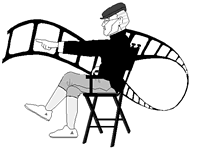 |
|
 |
||
 |
|

|
|
Unit
2 - Theatre History
Objectives: Resources: CELs: Components: Activities: Assignment
One - Written Review Early films assumed the eye of an audience member watching a play, it rarely moved and was placed 30 feet from the actors. D. W. Griffith changed that by using a variety of shots, including the close up and the zoom. He was also aware of light and shade compositions, and film editing. Film versions of an original stage play offers the director many more choices. Be aware of the differences you are seeing on film as opposed to a stage production. Students are to select a film to view and then complete a review and critique of the film. They should read the evaluation rubric before beginning the assignment. (watching film twice, 4 hours, writing review, 55 min.)
|
||||
|
Assignment Two - Interview "Thumbs Up, Thumbs Down" Students should stage their own TV shows with guest movie reviewers. They should bring on the special guests (groups of 4 or 5), and let them discuss the movies watched. The goal of the guest is to make the strongest argument. The audience can vote to determine the person with the most convincing argument (40 min).
Instructional
Strategies: Guiding questions, discussion, role play Alternative
On-Line Activity: Students should submit the written
critique as an attachment and e-mail it to the teacher.
The interview could be converted to a threaded discussion, as could
the talking circle. |





